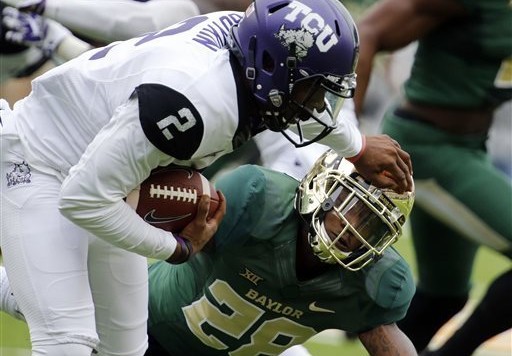After the Baylor Bears finished dragging his unit up and down the field Saturday afternoon, Oklahoma Sooners defensive coordinator Mike Stoops made a telling comment in the postgame press conference regarding his attitude going into the game:
“Well there is so much stress on your defense when you play Baylor. It is not only the scheme; it is the players who make the schemes. The matchups become very difficult and sometimes it is about which way would you like to die. Would you like to die slow or quick?”
While Baylor was looking for opportunities to toss bombs over the Sooners’ heads and steal OU quarterback Trevor Knight’s passes out of midair, Oklahoma’s top defensive strategist was telling his players to hang back and try not to get killed (too quickly).
Later that night, it was TCU thumping Kansas State en route to a tie at the top of the Big 12 standings with the Bears. KSU, a team that thrives on deliberate, fundamental football, just couldn’t keep up with the Horned Frogs.
With a month to go in the season, one — if not both — of these two teams will win the 2014 Big 12 title. They’ve rocketed to the top of the league with an aggressive style of play that puts the onus on opponents to counter their constant attacks.
The Big 12 has long held a reputation for chaos. Baylor and TCU seem to thrive on it, which helps explain the league’s new world order.
That’s nothing new for the Bears, who rose to prominence running head coach Art Briles’ prolific spread offense. Pairing that attack with defensive coordinator Phil Bennett’s pressure-centric scheme has turned Baylor into a formidable force on the national landscape, even if the Bears have taken a pass on proving themselves outside their league.
For TCU, on the other hand, the makeover has been extreme. After joining the Big 12 in 2012, Gary Patterson’s squad slogged through two years of trying to muck it up with its new conference mates. The Horned Frogs played low-margin ball, averaging 28.3 points per game in 2012 and 25.1 in 2013. That put them eighth overall in the Big 12 both years, just ahead of lowly Iowa State and Kansas.
In turning his offense over to spread gurus Doug Meacham and Sonny Cumbie, Patterson’s team finally has a unit worthy of sharing the sidelines with his superbly coached defense. The Horned Frogs have upped their scoring average to 47.2 points per game, second only to, you guessed it, Baylor. Meanwhile, the Horned Frogs’ ballhawks keep snagging turnovers (second in the nation with 27 on the season) and wrecking shop in opposing backfields (averaging 8 tackles for loss per game, fifth nationally).
If you’re looking for what separates the two Lone Star State programs from the rest of the conference, it’s that go-for-broke mentality. Their rivals in Austin crumbled in recent years under the nervous watch of Mack Brown, who spent his final three seasons at Texas trying to maintain a tenuous hold on his kingdom. Similarly, Oklahoma continues to sag under the weight of unfulfilled expectations. After so many years of pushing opponents around, the league’s two supposed superpowers are learning what it’s like to have the issue forced on them.
If they keep this up, Baylor and TCU will eventually learn about that whole hunter-versus-hunted dynamic. But that’s for another time. For now, one of them might just end up freewheeling into a national championship.

